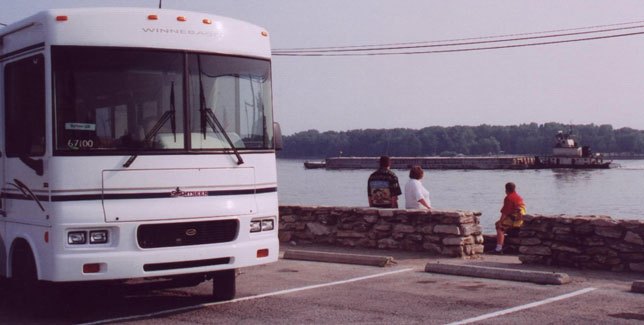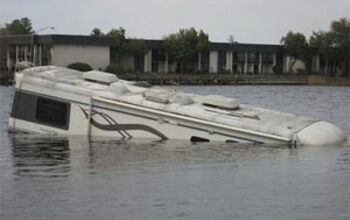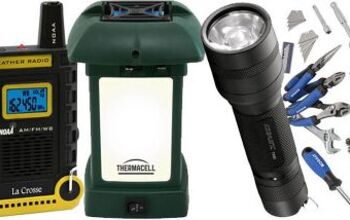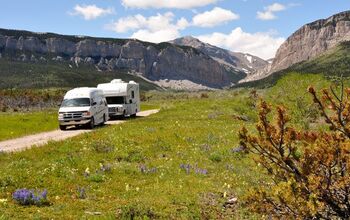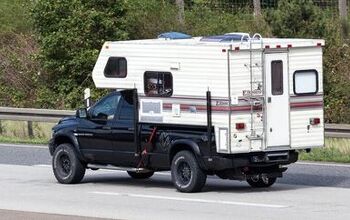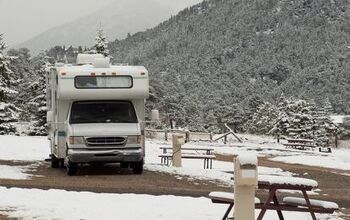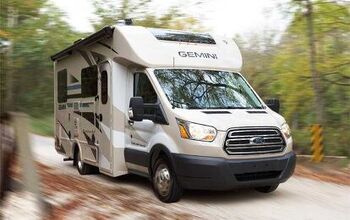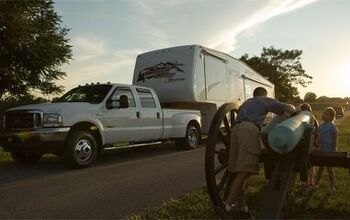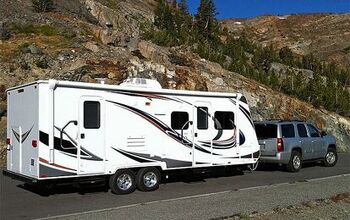2004 Winnebago Sightseer 30B Review
More. Winnebago’s product literature for the Sightseer repeatedly stresses that word. Flip open the brochure and the text directs you to “expect more”, be “more comfortable” and make use of the “StoreMore” system. These promises leapt out at me and stayed uppermost in my mind as I took the Sightseer and my family through the American Heartland for my road test. For nine days and 1,000 miles we took in the sights and more – with the 2004 30B Sightseer.
Winnebago says that the Sightseer is its most affordable Class A motorhome – but – it’s not supposed to look or perform like an entry-level unit, hence the heavy use of “more” in its marketing material. I tend to be skeptical of these come-ons – particularly the more-for-less promises. This is a tough trick to pull off – looking expensive but not being. With the Sightseer this character trait is up front and striking; it does look expensive. The bus-style front flows into one-piece fiberglass sidewalls that perch over a full basement storage system. Paint schemes and designs are simple and commanding. The rear is clean with a large automotive bumper and tail light casement. Marker lights (besides being functional) suggest a fondness for travel. Only the midship entry door signals that this unit is not more expensive.
But despite knowing what the price is, at first glance, it’s hard to see where the factory has made concessions to cut cost. Mind you they are there, they have to be, this motorhome is supposed to compete with units that are twenty, or thirty thousand dollars more expensive. So, with this in mind I spent most of my time looking for budget compromises – and deciding if I agreed with the factory’s choices.
Picking up the motorhome just outside Chicago afforded us a chance to spend some time in the Windy City. We’ve done this type of excursion several times now, and have come to enjoy the ease with which an RV and public transit gives us access to major cities without the hassle of driving and parking.
The following day – pointed towards Hannibal, MO, and the annual Tom Sawyer Days Festival (held over the Fourth of July holiday) – the Sightseer tackled Interstate speeds through flat farmland and 35 degree heat. The 30B Sightseer is built on a Ford chassis (GVWR of 18,000 lb.) and uses the 6.8L Triton V-10 engine as its power source. This motor has been doing duty in a variety of RVs for several years now; it’s strong (310 hp) and quite decent on gas. Coupled to a four-speed transmission with an overdrive lockout for hilly terrain, it moves the motorhome along smartly. Despite the fact the State of Illinois seems to think that RVs fall into the same category as tractor trailers (regulated to 55 mph) I comfortably cruised at the automobile limit – without a noticeable drop in fuel economy. Moderate side winds caused only slight body roll, and a minimum of effort on the steering held the Sightseer on course.
Often overlooked in tests, tires play an important role in handling and road manners. I was glad to see standard Goodyear 245/70R 19.5-inch radial tires on the Sightseer; these are good all-purpose tires that have a quiet highway tread. On-ramp acceleration was competent and the four-wheel antilock brake system was more than adequate. A 190-inch wheelbase is long enough to flatten out some bumps, but with a length of 370 inches it also means that your driving concerns should be directed to the tail swing of this unit. This is amplified by the front axle setting and wheel cut of the Ford chassis that makes this 30-footer nimble in its turning ability. The steering is light and its turning radius diameter is surprisingly small (just 31 feet). Just watch the back end. Winnebago obviously considered this because the large remote electric side mirrors (optional) and backup camera (optional) cover most of the usual blind spots.
The cab layout is simple and clean. Standard Ford gauges, along with lit flip toggles for auxiliary functions. The deep dashboard frames the split window (offers frame rigidity) where the bus-style wipers rest. It also houses the AM/FM stereo, cassette/CD (optional) and bumps up to the sliding glass side windows (with screen) on either side. Visibility is excellent, but the noise level less so. Engine noise is very well baffled, but wind noise from the side windows is annoying. There is a little too much flex in the frames and the gaskets need attention. In addition, the large dash may need additional anchor points. Mine shook and on larger bumps caused the CD to skip repeatedly. The factory Ford AC cools the front of the RV easily and over several hours, at speed, under load, in July heat – the temperature gauge never budged.
Crossing the Mississippi into Missouri we were soon setup in the aptly named “Injun Joe” Campground just outside Hannibal (boyhood home of Mark Twain, and backdrop for several of his books). Temperatures continued to rise (to 38 C and higher) but the thermostat controlled air conditioner never missed a beat (I also noted, outside it was very quiet, no complaints from the neighbors). The “One Place” systems center – all controls (hot water tank, water pump, refrigerator, gas, tank levels etc.) had to be set just once – after that they automatically switched between shore power and propane as needed.
Throughout the Sightseer I began to notice the choices that the design team had made, balancing cost with convenience. For instance, the Onan MicroQuiet gas generator (standard) has to be manually plugged into an outlet in the exterior service center. A simple solution that saves the cost of an automatic switch over between shore and generator power. A 130-watt inverter (often standard) is optional, again a cost compromise. These choices made sense to me, the plug is simple and with shore power and a generator, how often would I need 110V power from my DC batteries?
Another priority – space. The large slideout (138 inches) provides it, with economy. How? First with the use of an electrically-powered slide system, cheaper than hydraulic. Second, instead of a flat floor, Winnebago devotes resources to the StoreMore system that moves the basement storage out with the slide. Storage doors are lightweight but adequate, while inside I was glad to see that lights had not been left out. Each compartment has an AC/DC light, which is more important to me than heavy doors.
Then there are those things that don’t require cost sacrifice – just good engineering. The exterior service center puts all the valves and outlets in one central easy to access compartment. With lighting, pump switch and cleanup station (and Geni plug-in) this is an example of good design. Even the dump valves have color coded handles (grey and black) that just happened to be installed backwards on my unit. Of note inside is the swivel glider. It’s held in place with a quick-release latch – so you can put it where you want. What a simple joy as opposed to companies that insist on screwing the lounge seat into the floor. The master bedroom has an accordion-type plastic sliding door for privacy, this is adequate, but what’s better is a spring loaded hinge in the toilet door that holds it open, separating the salon from the bath and bedroom – that’s smart.
My wife was particularly happy to see a real oven in the Sightseer galley. Ovens are so handy, in a pinch – they’ll even make toast. Yet with many builders they have somehow fallen out of favor. The onus has been on the microwave, but even convection equipped ones can’t do what an oven can. In the Sightseer there is a standard microwave on board – but with the oven it can be smaller and non-convection.
The standard features that make up the Sightseer’s appliance/decor/fabrics package are just right for this price range of RV. I make this statement after having lived in it for a week. My sense (and more importantly my wife’s) on the function and comfort of the coach was that everything meshed well. There are lights where you need them, there is a bar for hanging wet clothes in the shower, there is a lot of hanging storage for shirts and skirts that can wrinkle, but only one night table – can you live with that?
Most of the cost-saving measures are ones you’ll never see, and some others just don’t matter. One note to Winnebago quality control – please watch for stripped screwheads, there were a few in our unit. Cost concessions did not seem to enter into the safety equation for the Sightseer. There was an assist handle outside, assist strap inside, detectors and alarms for LP leaks, smoke and carbon monoxide. There was a fire extinguisher, ground fault interrupter, high-mounted rear stop lamp, three-point seat belts in the cab, and lap belts in selected areas, a window escape and laminated safety glass for the windshield.
A nice touch for future upgrades is the pre-wiring that’s already in place for a digital satellite system, a second bedroom TV, VCR and backup camera. Some items you may want right away (I have to have a VCR) others you can install later – or not.
If you choose to go with the optional leveling jacks, you’ll be getting the hydraulic Kwikee touch pad control system ($5,246 MSRP). This is the only item on the optional list that I would say should be standard. A unit of this size (remember the rear overhang, plus the slideout) needs to be stabilized. Another standard feature is the 5,000 lb factory hitch, ready for your towed vehicle.
